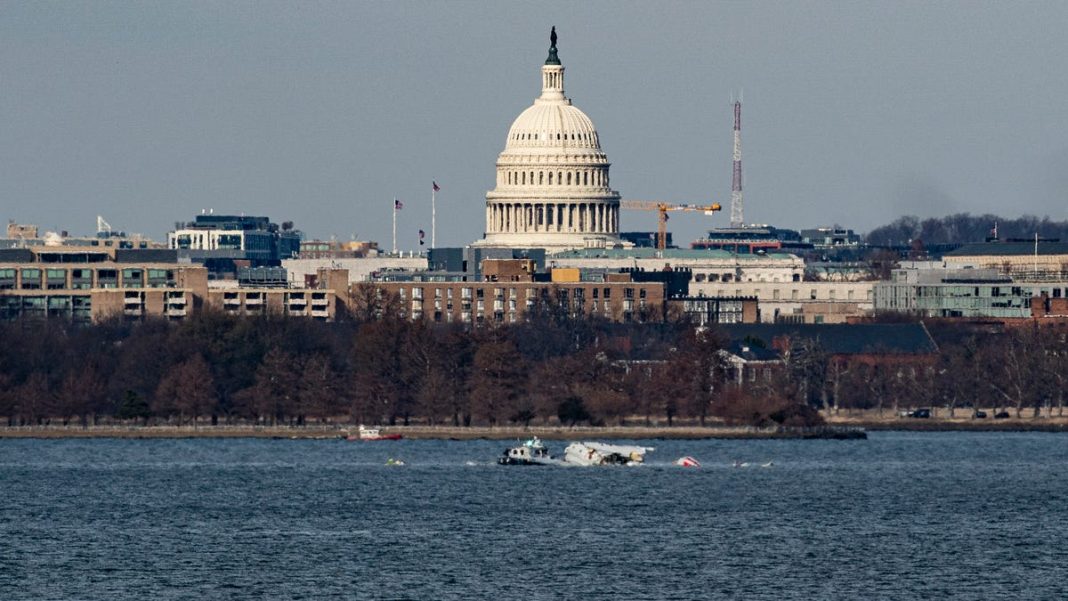An ‘unfortunate sequence of incidents’: Pilots discuss the DC plane crash
Many inquiries remain regarding the mid-air collision that took place on Wednesday night, involving a passenger aircraft and an Army helicopter. Pilots interviewed by YSL News suggest that a mix-up between the helicopter crew and air traffic control, along with poor visibility, might have contributed to the tragedy.
American Airlines Flight 5342 was approaching Ronald Reagan National Airport from Wichita, Kansas, when it collided with a Black Hawk helicopter around 9 p.m. Officials confirmed that there were no survivors, with all 64 passengers and crew on the plane, as well as three soldiers in the helicopter, losing their lives.
The investigation is still in progress.
“We simply don’t have all the information right now, and the real facts will not be revealed until we access the black boxes,” or data recorders used in aircraft, stated Chris Palmer, a commercial pilot and founder of the online flight school Angle of Attack. “We need to avoid jumping to conclusions.”
Insights from air traffic control recordings
Recordings from air traffic control suggest the helicopter crew was aware of the incoming passenger aircraft that had been flagged by air traffic control.
According to audio from LiveATC.net, a reputable source for flight recordings, air traffic control at Reagan National Airport inquired if the helicopter crew could see the plane and directed them to pass behind it. The helicopter pilot responded that they had the aircraft “in sight.”
The crash occurred just moments later, leading some pilots to theorize that the helicopter crew may have mistakenly identified the aircraft they were meant to watch for.
“The helicopter crew must have been focused on something else, misunderstanding what (air traffic control) communicated,” explained Laura Einsetler, a commercial pilot for a major U.S. airline and author of the Captain Laura blog.
“You might misidentify, then take your eyes off the situation for just a few seconds, and that’s all it takes. It’s just a tragic series of events,” Palmer remarked. “It seems to be a clear instance of human error.”
Defense Secretary Pete Hegseth mentioned that the helicopter crew was equipped with night-vision goggles. Einsetler noted that while these goggles can impair depth perception, visibility would still have been challenging even without them at that time and altitude.
“At night, our ability to see clearly decreases. From the Black Hawk pilot’s perspective, the regional jet can appear quite dark, as can the river or the runway, with city and airport lights creating a distracting backdrop,” she said. “Everything blends together.”
“From what I gather, it appears they did not identify the correct airplane, and visual misjudgments hindered their ability to see and avoid the incoming aircraft,” Palmer added.
President Donald Trump commented on Thursday that the helicopter should have been flying at a different altitude and “should have been more aware of their surroundings.”
“What was the helicopter doing in that area? Very tragic,” Trump stated during a White House press conference. “Someone should have noticed and removed that helicopter from danger, and they should have flown at a different altitude.”
It’s currently unknown if the plane or the helicopter strayed into restricted airspace. Senator Tammy Duckworth, D-Ill., who serves on the U.S. Committee on Commerce, Science & Transportation, announced her intention to seek information regarding their flight paths, as reported earlier by YSL News.
Lawmakers criticize congestion at Reagan National Airport
There are concerns that the traffic congestion at Reagan National Airport, one of the busiest in the nation, might have contributed to Wednesday’s crash.
Lawmakers from Maryland and Virginia previously argued that the airspace around the airport was overly congested, opposing legislation that would increase round-trip flights to Ronald Reagan Washington National Airport. This bill was enacted in May.
In a statement issued in February, four senators referred to this decision as “extremely reckless,” noting it would put added pressure on the runway at Reagan National Airport.
“The Committee is taking a risk with the safety of all who use this airport,” the letter stated. “Forcing the airport to handle additional flights in an already busy schedule will further strain its resources, especially when air traffic controllers are overworked, working long shifts six days a week.”
Einsetler, who noted that she has flown into Reagan National Airport numerous times, remarked that it is a “heavily trafficked airspace,” used by military flights, commercial airlines, and corporate aviation.
“As the investigation unfolds, we will likely see some measures established regarding how these various operations coexist in the same airspace,” she commented.
Robert Clifford, an attorney specializing in aviation law with experience in commercial flight incidents, has called for an immediate suspension of military flights in the area “until the situation is clarified.”
“It has long been acknowledged within local circles in Washington that Reagan Airport faces significant congestion,” Clifford noted. “There’s a clash between the operational needs of commercial and military aircraft in an airspace that’s restricted, given its proximity to the capital.”
More information will emerge as investigators analyze black boxes and interview witnesses. Trump confirmed that both the National Transportation Safety Board and the military are investigating the collision. The NTSB indicated on Thursday that it will likely release an initial report in roughly 30 days.
“Today marks the beginning of a long journey towards mourning, healing, and gathering the facts,” stated Jason Ambrosi, president of the Air Line Pilots Association, a union for pilots. “Many details and speculations will surface in response to this tragedy, but we must allow the investigation to proceed without interference.”

